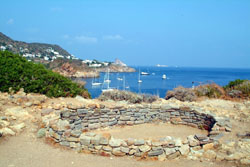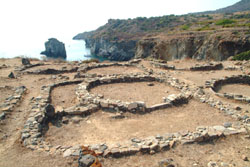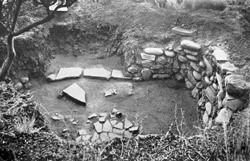
L. Bernaḅ Brea, M. Cavalier - Meligunìs Lipàra III
Stazioni preistoriche delle isole Eolie Panarea, Salina, Stromboli, Palermo 1968.
PART I. Archaeological exploration of the islands of Panarea and Stromboli.
PART II. Palaeoethnological exploration of the island of Salina.
APPENDIX. Potter's signatures and marks on Aeolian Bronze Age pottery.
The earliest evidence of human settlement so far found on the island of Panarea dates to the middle Neolithic period. Significant evidence of the Upper Neolithic (second half of the 4th millennium BC) has been found at Calcara (lower level) and on the summit of the island (Piano Cardosi). The evidence consists in the main of pottery of the Diana style. At Piano Quartara, a plateau above the beach of San Pietro, the traces of a small settlement of the final phase of the Aeneolithic (Copper Age) period (final centuries of the 3rd millennium BC) have been found. Tombs found in the area of Drauto (Panarea) and Malfa (Salina) can be dated, on the basis of correlations with equivalent finds on the Italian peninsula, to the beginning of the age of metal-working.
The Capo Graziano culture (early Bronze Age, first half of the 2nd millennium BC) is represented at Panarea by a group of distinctive pits approximately 1 m in diameter uncovered overlying the Neolithic level on the southern margin of the fumarole basin of Calcara; perhaps votive offerings to a deity sacred to volcanoes or perhaps more probably a divinity of good health.
The prehistoric settlement on the promontory of Milazzese dates to the middle Bronze Age. A score of circular huts, save one which is rectangular, have been excavated here.
The characteristics of Aeolian material culture during this period can be defined on the basis of the pottery recovered from the site. The numerous fragments of Mycenaean pottery of styles IIIA and IIIB enable this village to be dated between the 15th and early 13th century BC.
Like all the other minor islands in the archipelago, Stromboli seems not to have been permanently settled until the Upper Neolithic. Pottery dating to the Upper Aeneolithic have been found scattered on the Timpone di Ginostra, above the existing settlement.
At Salina the Capo Graziano culture is present at Serro dei Cianfi, a settlement only known from finds retrieved from a rubbish dump.
An important village of the Milazzese culture was brought to light at La Portella. The excavations have uncovered the foundations of ten or so huts built against the slope itself. As at Panarea, the violent destruction of the village has left evident traces, burying everything contained in the huts.
A catalogue of the potter’s marks found on Aeolian pottery of the Bronze Age follows. It has been extended to include similar potter’s marks found on pots excavated beyond the islands examined (Lipari, Filicudi and Milazzo).


